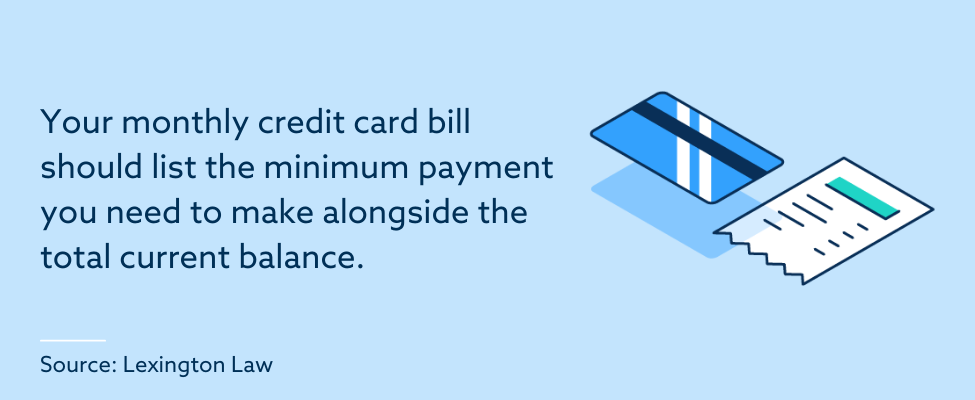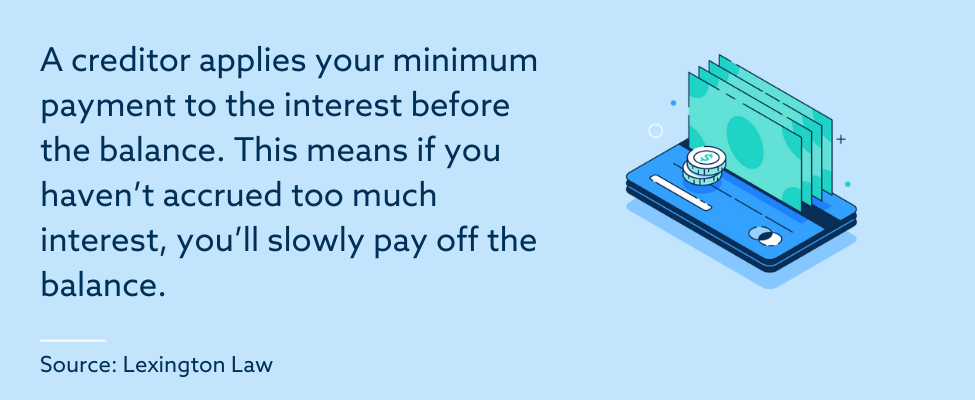
Your credit card’s minimum payment is the lowest amount you’re required to pay each month in order for your payments to still be considered on time and for you to avoid late fees.
The information provided on this website does not, and is not intended to, act as legal, financial or credit advice. See Lexington Law’s editorial disclosure for more information.
The minimum payment on a credit card is the lowest amount you’re required to pay each month in order for your payments to still be considered on time. You can always pay more than the minimum, but if you pay less, you might have to deal with accrued interest and late fees. While paying the minimum keeps you from falling behind, try to pay more as often as possible.
What is your credit card minimum payment?
Your monthly credit card bill should list the minimum payment you need to make alongside the total current balance. If you make the minimum payment by the end of your grace period each month, you’ll stay on track with no late fees. This allows you to maintain your credit score and good relationship with your lender when you’ve got other bills to pay.

However, while making only the minimum payment might seem convenient, it will also likely extend your repayment period by months or even years.
How are credit card minimum payments calculated?
Each credit card company calculates minimum payments differently. If your balance is less than a certain number, typically $25 or $35, your statement asks you to pay in full. Otherwise, your creditor might charge a small percentage of your balance or a flat fee like $25—whichever is more. This amount might include late fees if you’ve missed a few payments.
Review each company’s policies before you use their credit card so you know what to expect. Some cards charge higher fees than others for the same purchases. If you’re not sure how much your creditor charges, reach out to them before your next bill arrives.
What happens if you make only the minimum payment on your credit card?
Even though you might not want to, sometimes all you can make is the minimum payment. Here’s what can happen if this is the situation you’re in.
You’ll owe more in interest
After months of paying your credit card bills, you may feel you’re not making any progress. Your balance may still be large and limit your future purchases. This is because no matter how much you pay each month, if you carry any balance at all, it will accrue interest—and the longer you take to pay it all off, the more you’ll owe in interest. If you have enough debt, you might end up paying more in interest than you originally borrowed.
When you pay more than the minimum, you’ll pay off more of the balance, which decreases the amount that accumulates interest. This reduces your bill and allows you to pay off the debt more quickly. Over time, the amount you’re paying in interest shrinks until you’re focusing mainly on the principal.
You’ll delay fully paying off your debt
Likewise, sticking with the minimum payments increase your debt’s life span. Interest adds to the balance, and even if you have a low interest rate, you’re still paying only a fraction of your debt at a time. Paying $35 a month looks convenient now, but it’s less convenient when you’re still paying off a loan you took out years ago.
If your minimum payment is $25 and you pay $100 at once, you’ve reduced your debt’s potential life span by four months. Paying even a few extra dollars each month will help you eliminate your debt and focus on other bills. You’ll also free up money for new purchases on your credit card.
You may see your credit drop
Credit bureaus factor your credit utilization ratio into your credit score. Your utilization ratio is how much of your available credit you’re using—for example, carrying a balance of $500 out of a total limit of $1,000 is a 50 percent utilization rate—and when your ratio increases, your credit score might drop. Keeping your ratio as low as possible frees up your credit and shows bureaus you’re a responsible borrower.
FAQ about credit card minimum payments
Where can you find your credit card minimum payment?
You’ll find the credit card minimum payment on your bill, typically in the payment section. The bill also notes your payment due date and current balance. If you can’t find the information, call your creditor to check the balance.
What happens if you don’t make the minimum payment on your credit card?
When you don’t make the minimum payment, the credit card company might report the missed dates to credit card bureaus, which will likely drop your credit score and make it harder for you to take out future loans. Your creditor could also charge late fees and raise interest rates, increasing the length of time it takes to pay off your bill.
If you don’t pay off your debt for months, your creditor may sell your debt to a collection agency or file a lawsuit. A court might rule in favor of wage garnishing and allow creditors to take part of your paycheck. Ultimately, a debt that started with a few hundred dollars could cost you thousands of dollars over the next several years. That’s why it’s recommended that you prioritize making at least your minimum payments.
What does the CARD Act say about minimum payments?
For increased transparency, the Credit Card Accountability Responsibility and Disclosure (CARD) Act requires credit card companies to include a chart with your bill regarding minimum payments. The chart must show you how much to pay if you want to pay off the card in three years and note the amount of interest you’ll save.
Likewise, the chart must tell you how much interest you’ll accrue and how many years it’ll take to pay off the bill if you stick with minimum payments. In some cases, paying the minimum could increase the time frame by 20 years and add thousands of dollars in interest. This allows you to make an informed decision instead of assuming credit card companies have your best interests in mind.
The CARD Act also requires creditors to include a hotline where you can request credit counseling services. Typically, this hotline appears underneath the chart.
How is the minimum payment applied to the total card balance?
A creditor applies your minimum payment to the interest before the balance. If you haven’t accrued too much interest, you’ll slowly pay off the balance with your minimum payments. However, if you keep making purchases and the interest builds, your minimum payment will go to the interest without touching your balance. Since the principal keeps earning interest, you might end up with thousands of dollars’ worth debt you didn’t plan for.

Pay what you can to protect your finances
If you’re on a tight budget, you might have to make the minimum payment to cover the rest of your bills. Some people do this for a month or two until they improve their financial situation. However, if you’re making the minimum payment every month and getting frustrated by the lack of progress, you might want to reevaluate your finances.
Lexington Law offers a free credit assessment that gives you your credit score, credit report summary and recommended steps to improve your credit. Once we’ve discussed your assessment, we can talk about services like credit disputes, creditor interventions and identity protection that can help you work on your credit and take control of your debt. Reach out to Lexington Law to learn more about our firm.
Note: Articles have only been reviewed by the indicated attorney, not written by them. The information provided on this website does not, and is not intended to, act as legal, financial or credit advice; instead, it is for general informational purposes only. Use of, and access to, this website or any of the links or resources contained within the site do not create an attorney-client or fiduciary relationship between the reader, user, or browser and website owner, authors, reviewers, contributors, contributing firms, or their respective agents or employers.
